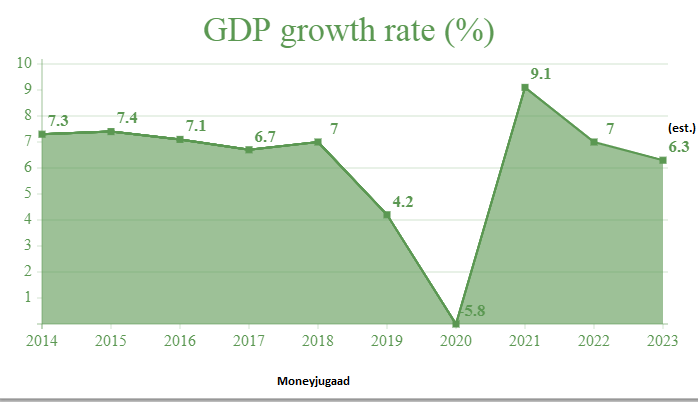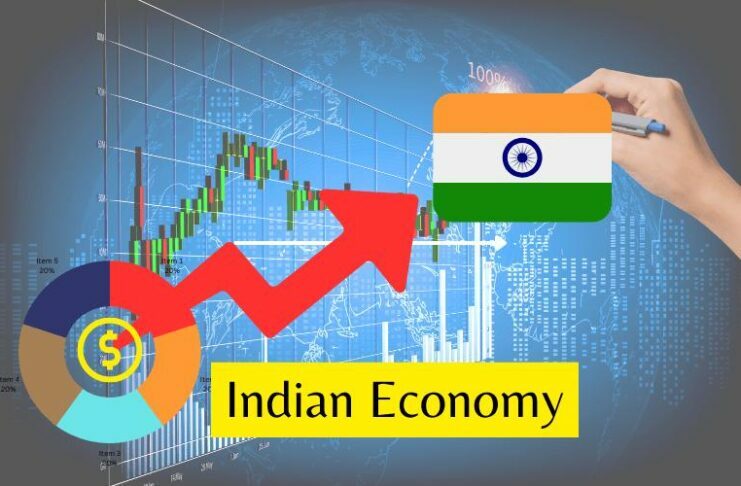India’s economy has been experiencing impressive growth in recent decades, establishing itself as a major global player. With an average annual GDP growth rate of about 7%, while the world has faces economic slow down, the country has proven its resilience in the face of economic challenges. Its vast and diverse market offers ample opportunities for businesses to thrive and expand.
International Monetary Fund (IMF) projections for 2028 that India be the third largest economy by the end of this decade and remains one of the fastest growing economy in the world.
India’s Ascent to Becoming the World’s Second-Biggest Economy : Goldman Sachs
Goldman Sachs one of the Largest and Credible Investment Bank in the World has predict that India will be the Second Biggest Economy in the World beating America by 2075. Its rapidly growing economy, large consumer base, pro-business policies, and favorable investment climate make it an appealing choice for both local and global investors.
The Main Sectors Of Indian Economy:
The Indian economy holds the distinction of being the world’s fifth-largest in terms of nominal GDP and the third-largest based on purchasing power parity. This underscores India’s significant economic influence and its strong capacity for purchasing goods and services. The economic structure of India is a blend of public and private sectors, with the public sector playing a particularly vital role in key strategic areas.
In recent times, India’s economy has demonstrated impressive growth, marked by a rapid pace of advancement. This encouraging trend is anticipated to persist in the years ahead, signifying a promising trajectory for India’s economic journey.
The Indian economy is divided into three primary sectors:
- Primary Sector: This sector encompasses activities like agriculture, forestry, fishing, and mining. In the fiscal year 2024, it constituted around 18.4% of India’s GDP. While the smallest in terms of GDP share, it remains significant due to its substantial employment generation.
- Secondary Sector: The secondary sector involves manufacturing, construction, and utilities. It accounted for approximately 28.3% of India’s GDP. Manufacturing, a crucial component, benefits from a well-trained workforce, favorable investment conditions, and increasing governmental support. This sector plays a pivotal role in the economy’s growth trajectory.
- Tertiary Sector: Dominating the Indian economy, the tertiary sector covers services such as transportation, communication, trade, education, and healthcare. Its share in the GDP reached 53.3%. Urbanization, rising incomes, and a growing demand for services like education and healthcare contribute to its sustained expansion.
The future is anticipated to bring shifts in the contribution of these sectors to India’s GDP. The tertiary sector is poised to maintain its upward trajectory, driven by persistent growth in services. The secondary sector is expected to grow moderately, supported by skilled labor, conducive investment conditions, and governmental backing. Meanwhile, the primary sector’s growth is projected to be more measured due to inherent limitations like land scarcity, water challenges, and productivity concerns.
India’s Economy: The Next Global Powerhouse
India has become one of the fastest-growing major economies globally and is likely to be among the top three economic powers by the end of this decade. This growth is supported by its strong democracy and partnerships. In the financial year 2024, India’s total economic output, known as GDP, is estimated to be about US$ 3.12 trillion. India also has more than 100 “unicorns,” which are special startups valued at a combined total of about US$ 332.7 billion. This is the third-highest number of unicorns in the world.

GDP Surges Beyond Expectations at 8.4% in 2024 – Read Here
The government is working to produce energy from renewable sources and aims to get 40% of its energy from non-fossil fuels by 2030. According to a study by McKinsey, India needs to create a lot of new jobs (around 90 million) that are not related to farming between 2023 and 2030. This will help increase productivity and economic growth. To achieve this, the number of jobs added each year needs to grow by 1.5% from 2023 to 2030. This will also help the economy to grow between 8% and 8.5% during that time.
According to Mr. Piyush Goyal, who is a government minister responsible for trade and industry, India hopes to achieve exports (the things it sells to other countries) worth US$ 1 trillion by the year 2030.
SBI Research Predicts Sevenfold Growth in Indian Per Capita Income by FY47:
As per SBI Research, the average income earned by each Indian, referred to as per capita income, is poised for a substantial surge. Currently, in the fiscal year 2023, it stands at approximately US$ 2,557.62 (equivalent to around Rs. 2.12 lakh). However, by the year 2047, which aligns with India’s 100th year of independence, this figure is projected to escalate to US$ 17,870.96 (approximately Rs. 14.9 lakh).
Ms. Soumya Kanti Ghosh, a prominent figure at State Bank of India, shared insightful data. In 2014, the average income hovered around US$ 5,277.33 (Rs. 4.4 lakh). By 2023, it surged to US$ 15,592.11 (Rs. 13 lakh). This uptick in earnings occurred due to an increased number of individuals reporting their income and fulfilling tax obligations. She posits that the middle class is expanding its presence, exhibiting a forward-looking attitude and optimism about the future, contrary to some other studies. This positive outlook might necessitate a fresh perspective, given the unique situation where new opportunities are emerging as the economy evolves and more people engage in temporary work arrangements.
The projected population growth in India expects an increase from 1.4 billion in 2023 to 1.6 billion in 2047. Correspondingly, the workforce is estimated to expand from 530 million in 2023 to 725 million in 2047. This would represent a larger share of the total population, rising from 37.9% in 2023 to 45% in 2047. SBI Research further anticipates a rise in the number of employed individuals who pay taxes, from 313 million in 2023 to 565 million in 2047. The number of individuals filing income tax returns is projected to surge from 70 million in 2023 to 482 million in 2047.
Prime Minister Modi says India’s exports rising rapidly, world rating agencies recognizing India’s potential:
Prime Minister Mr. Narendra Modi emphasized that the country’s exports are rapidly increasing, and the global community anticipates India’s continued growth. He highlighted how international rating agencies are praising India, and in the aftermath of the pandemic, the world is recognizing the skills and capabilities of Indians.
During a period when global supply chains faced disruptions, India showcased that addressing people’s needs is the key to finding effective solutions. The Prime Minister emphasized that India has emerged as a prominent voice for the Global South, and its economy has become an essential component of the global supply chain, contributing to overall stability.
The Prime Minister also pointed out that India’s young generation has propelled the nation into one of the top three startup ecosystems worldwide. He further expressed that this achievement has left a profound impression on young individuals globally, particularly when they witness the remarkable talents of India’s youth.
In today’s technology-driven world, India’s expertise holds significant sway in the international arena. The Prime Minister additionally stated that leaders from developed nations have acknowledged the success of India’s Digital India initiative and are keen on understanding and adopting similar efforts.
What are the factors that have contributed to the growth of the Indian economy?
Strong domestic demand: The Indian economy is driven by strong domestic demand, which is supported by a young and growing population.
The Indian government has undertaken a number of reforms in recent years.
Foreign investment: Foreign investment has also been a major driver of growth in the Indian economy.
* Infrastructure development: The Indian government is investing heavily in infrastructure development, which is expected to boost economic growth in the coming years.
What are the major sectors of the Indian economy?
* Agriculture: Agriculture is the largest sector of the Indian economy, accounting for about 15% of GDP and employing about 40% of the workforce.
* Manufacturing: Manufacturing is the second largest sector of the Indian economy, accounting for about 18% of GDP and employing about 17% of the workforce.
* Services: Services is the fastest-growing sector of the Indian economy, accounting for about 57% of GDP and employing about 33% of the workforce.
What are the key trends in the Indian economy?
The rise of the middle class: The Indian middle class is growing rapidly, and this is driving demand for goods and services.
* The growth of the services sector: The services sector is the fastest-growing sector of the Indian economy, and it is expected to continue to grow in the coming years.
* The growth of the digital economy: The digital economy is growing rapidly in India, and it is expected to have a major impact on the economy in the coming years.








[…] Know All Information – About The Indian Economy : Growth Rate & Statistics […]
[…] Read More – The Indian Economy : All Information Growth Rate & Statistics […]
[…] Know More About – The Indian Economy : All Information Growth Rate & Statistics […]
[…] The Indian Economy : All Information Growth Rate & Statistics […]
[…] Key Points: Its vast and diverse market offers ample opportunities for businesses to thrive and expand.International Monetary Fund (IMF) projections for 2020 to 2028 that India be the third largest economy by the end of this decade and remains one of the fastest growing economy in the world.Read More for Indian Economy the World’s Fastest Growing Economy and diverse Investment Opport… […]
[…] Also Read – The Indian Economy : All Information Growth Rate & Statistics […]
[…] Also Know- The Indian Economy : All Information Growth Rate & Statistics […]
[…] Also Know- The Indian Economy : All Information Growth Rate & Statistics […]